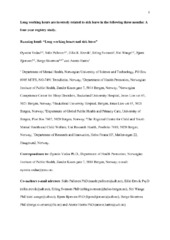Long working hours are inversely related to sick leave in the following 3 months: a 4-year registry study
Vedaa, Øystein; Pallesen, Ståle; Erevik, Eilin K.; Svensen, Erling; Waage, Siri; Bjorvatn, Bjørn; Sivertsen, Børge; Harris, Anette
Peer reviewed, Journal article
Accepted version

View/
Date
2019-05Metadata
Show full item recordCollections
Original version
https://doi.org/10.1007/s00420-018-1372-xAbstract
Purpose: The aim of this study was to investigate the effects of long working hours (≥ 12 h shifts) on sick leave using objective records of shift work exposure and of sick leave. Methods: A total of 1538 nurses (mean age 42.5, SD 12.0; response rate 42%) participated. Payroll and archival sick leave data over a 4-year period were retrieved from employers’ records and aggregated over every third calendar month. A multilevel negative binomial model was used to investigate the effects of exposure to long working hours, on subsequent sick leave rates the following 3 months. Covariates included prior sick leave, number of shifts worked, night and evening shifts, personality, and demographic characteristics. Results: Exposure to long working hours was associated with fewer sick leave days in the subsequent 3 months [adjusted model, incidence rate ratio (IRR) = 0.946, 95% CI 0.919–0.973, p < 0.001]. The interaction long working hours by a number of work days showed that sick leave days the subsequent 3 months was higher by long shifts when number of shifts was high compared to when number of shifts was low [adjusted model, IRR 1.002, 95% CI 1.000–1.004, p < 0.05]. Discussion: Long working hours was associated with fewer sick leave days. The restorative effects of extra days off with long working hours are discussed as possible explanations to this relationship.